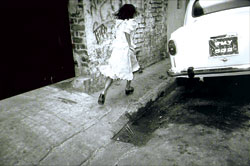 WASHINGTON-Amidst an epidemic of charity photography and documentary-making, it is instructive to see Born into Brothels, the film that bagged the Academy Award in the documentary feature category in February 2005.
WASHINGTON-Amidst an epidemic of charity photography and documentary-making, it is instructive to see Born into Brothels, the film that bagged the Academy Award in the documentary feature category in February 2005.
The film by Zana Briski and Ross Kaufman gives a new global face to the Sonagachi red district in Calcutta with a very personal search for a glimpse of the lives of children who live in that hidden world.
New York-based photojournalist Zana makes her first trip to India in 1995 to produce a story on female infanticide. She returns in 1997 to begin her project in the red light district of Sonagachi. Living in the brothels for months at a time she is struck by the cheers and tears of children born in the brothels who later become the final destination for her photography and filming as she tries to get the kids into a school.
She gives these children new pairs of eyes and teaches them how to capture their visions in still pictures. Her own visions preserved in the film are the corollary of those of the children. The children get a chance to be reborn, so does the filmmaker. It is this unmistaken unity that appears time and again between the two sets of visions, which collectively weave the central theme of the film: it is about life, about being born-symbolically if not physically. The location, Calcutta or Manhattan, is irrelevant.
Eleven-year-old Avijit likes depicting suffering in his photographs "because it is the truth". Ten-year-old Kochi dislikes one particular photograph "because it's a head sticking out". Zana likes the same photograph "because it's a head sticking out". All these statements from the photography classes develop a bond that connects the children, the filmmaker and their immediate and distant surroundings. The fact that Zana comes from a world that is antipolar to the children's is of little relevance throughout their common journey.
We are led through a narrow, stingy alley as soul-rich music plays in the background. It is an island in the ocean, a patch of territory where women have learned to separate their sexual offerings from their family spirit, their profession from their personal worlds, their bodies from their souls.
Even without really seeing her chemistry with the brothel women, at least not in the film, one senses a feminine touch in Zana's relationship with their children. How the eight children relate to their immediate worlds is diverse and equally diverse is Zana's relationship with each of them. In the epilogue, Avijit listens to his grandmother but not to his father, decides in the end to return to his own school from one that Zana had enrolled him to which requires him repeating one grade. Puja, who is not visibly poor and who giggles that she won't be sent to a boarding schools because she is her parents only daughter, indeed drops out of the boarding school. Suchitra, who quietly takes everything that's given to her, drops out of school to join the line for her aunt's sake.
Kochi, the shiest of all who takes pictures to escape her surroundings, is the only one who remains in Sabera Foundation, the school Zana had chosen for the kids. About halfway through the film, we hear Zana's efforts for the children's education become more urgent as she thinks of Kochi who will not say no to being a prostitute because "she has never said no to anything".
But in her monologues, Kochi does wonder what it would be like if she was studying. Her photography carries verticals and horizontals within whose frames she tries to place her objects: a girl standing right below the moon, where the two almost metamorphose into one in the creamy moonlight, or is it the whiteness of the girl's outfit? Trying to hide her face with a shy smile as her bold friend tries to take her shot, Kochi certainly presents a paradoxical existence where she is firmly rooted in her own self but evades her surroundings.
Born into Brothels has evoked a vibrant debate on the internet.
Born Into Brothels - Calcutta's Red Light Kids
Directed by Zana Briski and Ross Kaufmann
2004
85 Minutes
Kids with cameras  Ten-year-old Manik's picture of Puja (top) is among photographs taken by the children of prostitutes working in Calcutta's red light district. More than 7,000 women and girls work as prostitutes here and only one group has a lower standing: their children. Zana Briski (right) became involved in the lives of these children in 1998 when she first began photographing prostitutes. Living in the brothels for months at a time, she quickly developed a relationship with many of the kids who, often terrorised and abused, were drawn to the rare human companionship she offered.
Ten-year-old Manik's picture of Puja (top) is among photographs taken by the children of prostitutes working in Calcutta's red light district. More than 7,000 women and girls work as prostitutes here and only one group has a lower standing: their children. Zana Briski (right) became involved in the lives of these children in 1998 when she first began photographing prostitutes. Living in the brothels for months at a time, she quickly developed a relationship with many of the kids who, often terrorised and abused, were drawn to the rare human companionship she offered.
Fascinated by her camera, Zana thought it would be great to see the world through their eyes and held weekly photography workshops between 2000 and 2003. Equipped with inexpensive point-and-shoot 35mm cameras, the children produced incredible work. Their images are explosions of colour: self-portraits, family pictures, street scenes, stunning tableaus of Bengali life.
www.kids-with-cameras.org


